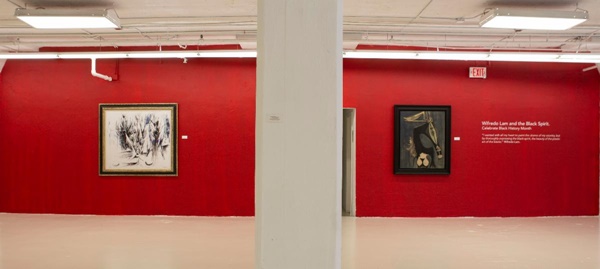Wifredo Lam

GARY NADER ART CENTRE
62 NE 27th St. Miami, FL 33137Tel:3055760256 Fax:3055760948 email


Closes May 31, 2020


“My return to Cuba meant, above all, a great stimulation of my imagination, as well as the exteriorization of my world,” Lam recounted of his celebrated homecoming in 1941. “I responded always to the presence of factors which emanated from our history and our geography, tropical flowers, and black culture.” His embrace of what he termed “la cosa negra” came to define his re-acquaintance with the island, after eighteen years in Europe, and informed the syncretic cubanidad of his work over the decade that followed.1 “I wanted with all my heart to paint the drama of my country, but by thoroughly expressing the negro spirit, the beauty of the plastic art of the blacks,” he later reflected. “In this way I could act as a Trojan horse that would spew forth hallucinating figures with the power to surprise, to disturb the dreams of the exploiters. . . . A true picture has the power to set the imagination to work, even if it takes time.”2 His seminal paintings from this period, among them the paradigmatic Jungle (1943), teem with transgressive figures of the kind Lam describes, beings that emanate from the rich Afro-Cuban imaginary to which he was exposed. Exemplary among them are his inimitable femmes cheval, or horse-headed women, whose hybrid morphology elegantly elides Surrealist subversion and Santería ceremonial practice.
Lam’s arrival in Cuba dovetailed with rising interest in Caribbean vernacular culture, spanning the Négritude movement led by his friend Aimé Césaire, the Martinican poet, and the pioneering ethnographic and anthropological studies of Lydia Cabrera and Fernando Ortiz. Their recuperation of Afro-Cuban culture, particularly its folklore and religious customs, paralleled Lam’s own engagement with the Lucumí, or Santería, religion, which he had studied as a child with his godmother Ma’Antonica Wilson, a Yoruba priestess. “Lam began to create his atmosphere,” the writer Alejo Carpentier observed, “using figures in which the human, the animal, and the vegetal mixed without boundaries, animating a world of primitive myths with something ecumenically Antillean, bound deeply not only to the soil of Cuba, but to the larger chain of islands.” In his commingling of “all that is magical, imponderable, mysterious in our midst,” Lam invoked the sacred, animistic universe of Santería, to which his metamorphosing bodies and landscapes partly belong.3
The femme cheval first appeared in Lam’s Fata Morgana drawings (1940-41), made to illustrate André Breton’s Surrealist poem, but her evolved expression in his paintings from 1947 to 1950 marks the apotheosis of her persona. She is distinguished by a variety of head shapes—round, trumpet, detached, hatted, doubled, spiked—and anatomical stylizations, whose references span Santería (the horned Eleggua head) and traditional Spanish dress (the mantilla). As a personifcation of ritual possession in Santería, the femme cheval evinces the lush carnality of the feminine body and its supernatural powers. “The endowing of the femme cheval with an animal head is most often interpreted literally as a representation of the devotee of the orishas as the ‘horse’ of the deity, who mounts the believer during ritual ceremonies,” noted Lam scholar Lowery Stokes Sims explains, describing the fgure’s given role. Yet the femme cheval also stands as an “emblem of Surrealist hybridity – the minotaur,” she continues, simultaneously rendered through a transposition of gender in which the artist shifts “the power focus of Surrealism (and Picasso) from the male principle to the female.”4
The present Figure is a classic incarnation of Lam’s femme cheval, her syncretic body drawn in a seductive state of transfiguration. A long, black neck curves angularly into a familiar, trumpet-shaped head, superimposed by the pale oval of her face, similar to that of the handsome Lisamona (1950). Framed by an intermediary and semitransparent diamond shape, her features are abstracted and bifurcated along a chevron-striped line. Her elongated head, extending from its bulbous, testicle-shaped chin to its tapering horns, is visually offset by the knife, or machete, that hovers in the space behind her; its crescent shape is echoed in the two spikes that protrude from her fringed, foral mane. These mystical and erotic attributes, from her papaya-shaped breasts to her hybridized visage and mane, are highlighted in tonal shadings of beige that faintly overlay the raw canvas. Set against a painterly grey ground and the fattened darkness of her equine body, they illuminate the shape-shifting magic embodied in Lam’s femme cheval, avatar of Afro-Cuba in the words of Césaire, in the closing stanza of a poem he addressed to his friend:
avatars however of a god keen on destruction monsters taking fight in the combats of justice I recognized the rare laughter of your magical weapons the vertigo of your blood and the law of your name.5
Abby McEwen, Assistant Professor, University of Maryland, College Park
1 Wifredo Lam, quoted in Lowery Stokes Sims, Wifredo Lam and the International Avant-Garde, 1923-1982 (Austin: University of Texas Press, 2002), 35.
2 Lam, quoted in Max-Pol Fouchet, Wifredo Lam (New York: Rizzoli, 1976), 188-89.
3 Alejo Carpentier, “Refexiones acerca de la pintura de Wifredo Lam,” Gaceta del Caribe 5 (July 1955): 27.
4 Sims, Wifredo Lam and the International Avant-Garde, 117.
5 Aimé Césaire, “Wifredo Lam…” (1983), trans. Clayton Eshleman and Annette Smith, in Callaloo 24, no. 3 (Summer 2001): 712.
Lam’s arrival in Cuba dovetailed with rising interest in Caribbean vernacular culture, spanning the Négritude movement led by his friend Aimé Césaire, the Martinican poet, and the pioneering ethnographic and anthropological studies of Lydia Cabrera and Fernando Ortiz. Their recuperation of Afro-Cuban culture, particularly its folklore and religious customs, paralleled Lam’s own engagement with the Lucumí, or Santería, religion, which he had studied as a child with his godmother Ma’Antonica Wilson, a Yoruba priestess. “Lam began to create his atmosphere,” the writer Alejo Carpentier observed, “using figures in which the human, the animal, and the vegetal mixed without boundaries, animating a world of primitive myths with something ecumenically Antillean, bound deeply not only to the soil of Cuba, but to the larger chain of islands.” In his commingling of “all that is magical, imponderable, mysterious in our midst,” Lam invoked the sacred, animistic universe of Santería, to which his metamorphosing bodies and landscapes partly belong.3
The femme cheval first appeared in Lam’s Fata Morgana drawings (1940-41), made to illustrate André Breton’s Surrealist poem, but her evolved expression in his paintings from 1947 to 1950 marks the apotheosis of her persona. She is distinguished by a variety of head shapes—round, trumpet, detached, hatted, doubled, spiked—and anatomical stylizations, whose references span Santería (the horned Eleggua head) and traditional Spanish dress (the mantilla). As a personifcation of ritual possession in Santería, the femme cheval evinces the lush carnality of the feminine body and its supernatural powers. “The endowing of the femme cheval with an animal head is most often interpreted literally as a representation of the devotee of the orishas as the ‘horse’ of the deity, who mounts the believer during ritual ceremonies,” noted Lam scholar Lowery Stokes Sims explains, describing the fgure’s given role. Yet the femme cheval also stands as an “emblem of Surrealist hybridity – the minotaur,” she continues, simultaneously rendered through a transposition of gender in which the artist shifts “the power focus of Surrealism (and Picasso) from the male principle to the female.”4
The present Figure is a classic incarnation of Lam’s femme cheval, her syncretic body drawn in a seductive state of transfiguration. A long, black neck curves angularly into a familiar, trumpet-shaped head, superimposed by the pale oval of her face, similar to that of the handsome Lisamona (1950). Framed by an intermediary and semitransparent diamond shape, her features are abstracted and bifurcated along a chevron-striped line. Her elongated head, extending from its bulbous, testicle-shaped chin to its tapering horns, is visually offset by the knife, or machete, that hovers in the space behind her; its crescent shape is echoed in the two spikes that protrude from her fringed, foral mane. These mystical and erotic attributes, from her papaya-shaped breasts to her hybridized visage and mane, are highlighted in tonal shadings of beige that faintly overlay the raw canvas. Set against a painterly grey ground and the fattened darkness of her equine body, they illuminate the shape-shifting magic embodied in Lam’s femme cheval, avatar of Afro-Cuba in the words of Césaire, in the closing stanza of a poem he addressed to his friend:
avatars however of a god keen on destruction monsters taking fight in the combats of justice I recognized the rare laughter of your magical weapons the vertigo of your blood and the law of your name.5
Abby McEwen, Assistant Professor, University of Maryland, College Park
1 Wifredo Lam, quoted in Lowery Stokes Sims, Wifredo Lam and the International Avant-Garde, 1923-1982 (Austin: University of Texas Press, 2002), 35.
2 Lam, quoted in Max-Pol Fouchet, Wifredo Lam (New York: Rizzoli, 1976), 188-89.
3 Alejo Carpentier, “Refexiones acerca de la pintura de Wifredo Lam,” Gaceta del Caribe 5 (July 1955): 27.
4 Sims, Wifredo Lam and the International Avant-Garde, 117.
5 Aimé Césaire, “Wifredo Lam…” (1983), trans. Clayton Eshleman and Annette Smith, in Callaloo 24, no. 3 (Summer 2001): 712.
 |
Wifredo Lam |








